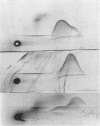Abstract
Two siblings with m ild hemorrhagic symptoms had combined functional deficiencies of vitamin K-dependent clotting factors. Prothrombin (0.18-0.20 U/ml) and Stuart factor (Factor X, 0.18-0.20 U/ml) and Stuart factor (Factor X, 0.18-0.20 U/ml) were most severely affected. Antigenic amounts of affected coagulation factors were normal and normal generation of thrombin activity occurred in the patients' plasmas after treatment with nonophysiologic activators that do not require calcium for prothrombin activation. Hepatobilary disease, malabsorptive disorders, and plasma warfarin were not present. Both parents had normal levels of all coagulation factors. The patients' plasmas contained prothrombin that reacted both with antibody directed against des-gamma-carboxyprothrombin and native prothrombin. Crossed immunoelectrophoresis of patients' plasmas and studies of partially purified patient prothrombin suggested the presence of a relatively homogeneous species of dysfunctional prothrombin, distinct from the heterologous species found in the plasma of warfarin-treated persons. These studies are most consistent with a posttranslational defect in hepatic carboxylation of vitamin K-dependent factors. This kindred uniquely possesses an autosomal recessive disorder of vitamin K-dependent factor formation that causes production of an apparently homogeneous species of dysfunctional prothrombin; the functional deficiencies in clotting factors are totally corrected by oral or parenteral administration of vitamin K1.
Full text
PDF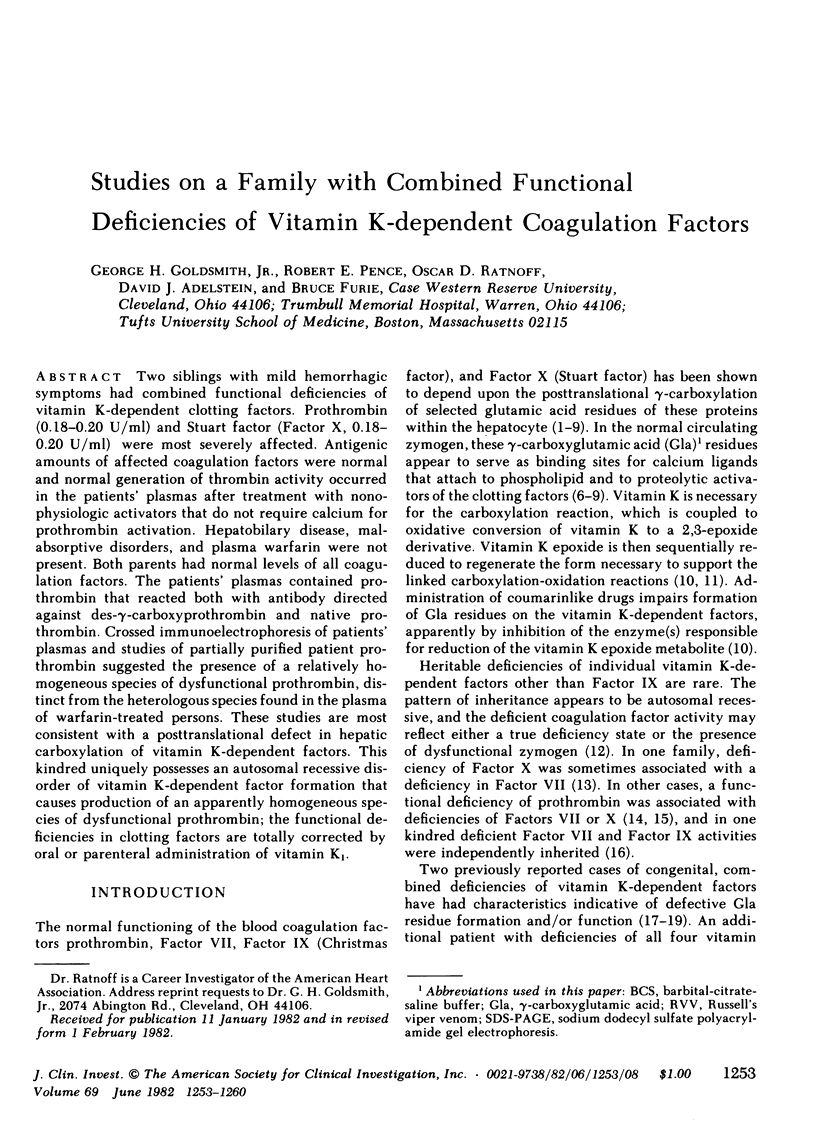
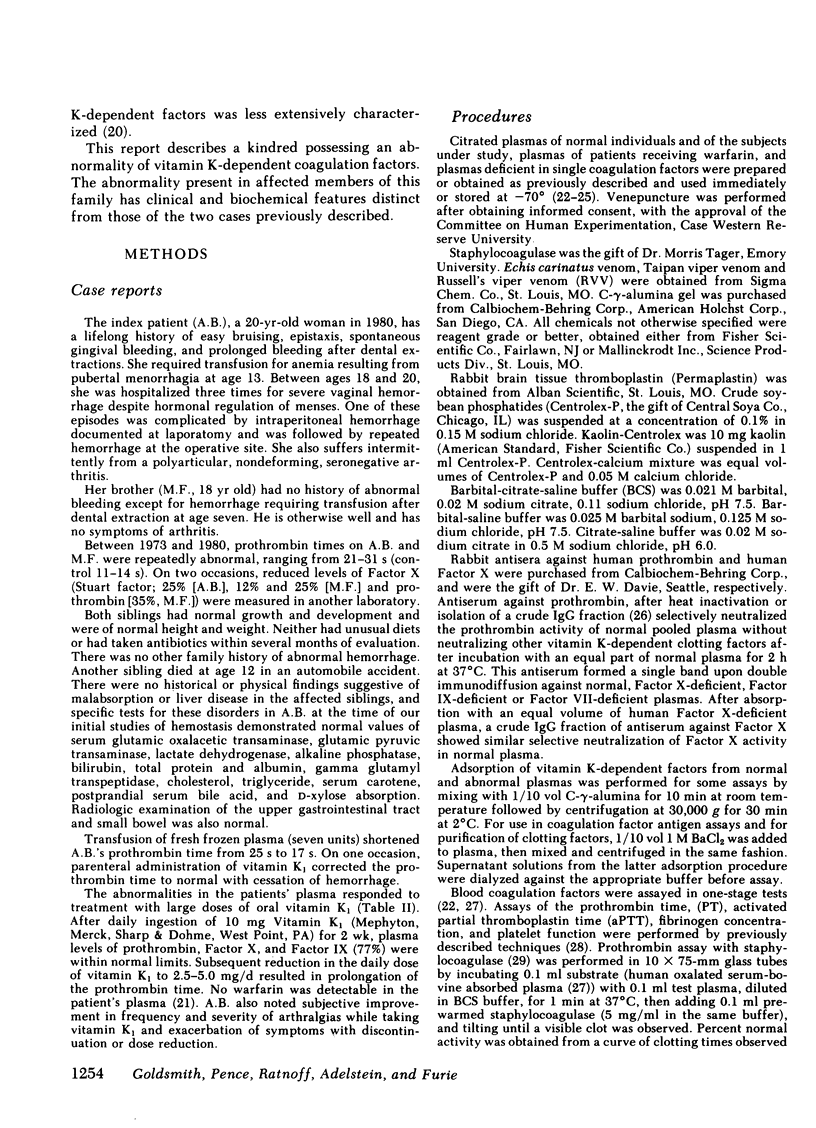
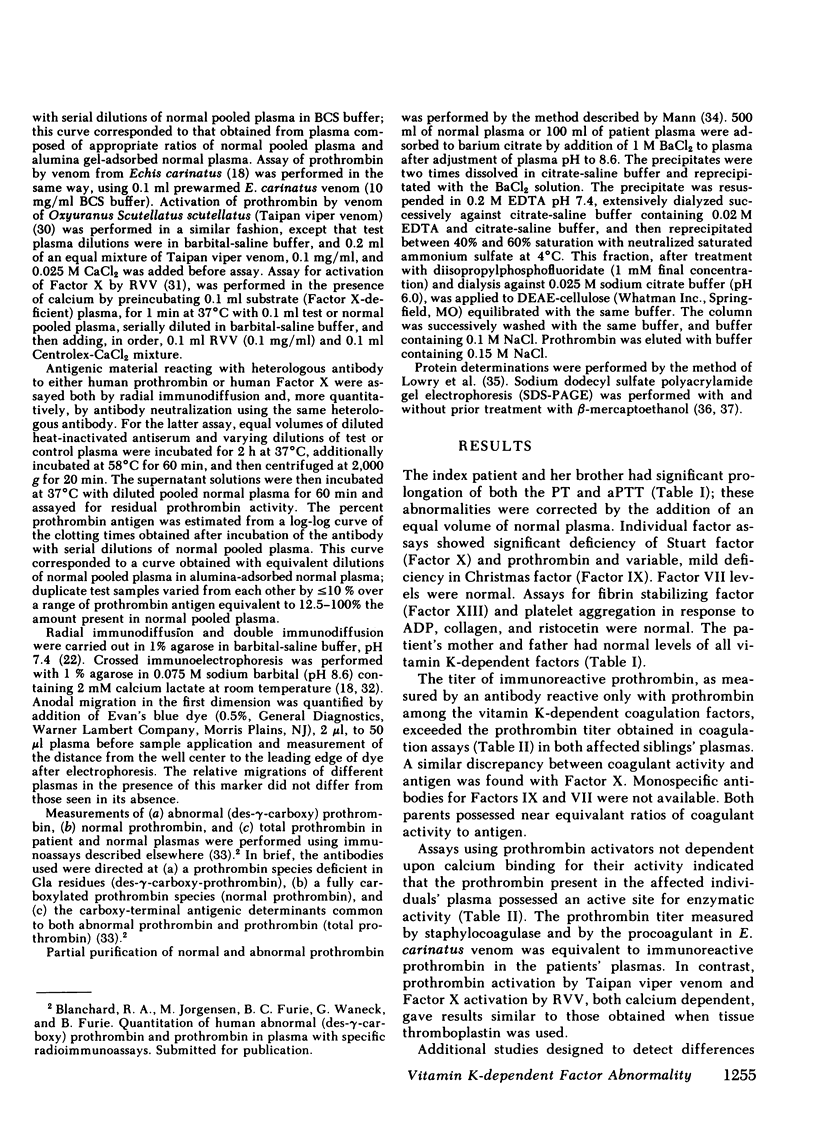

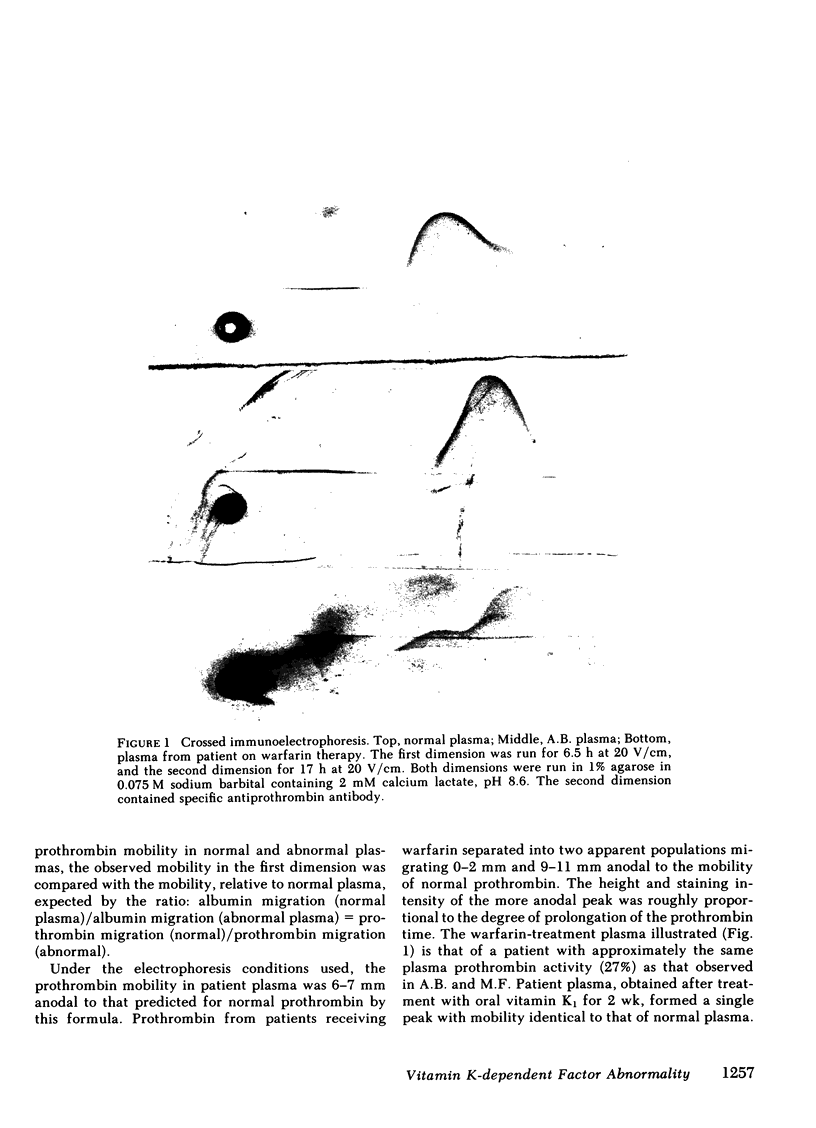
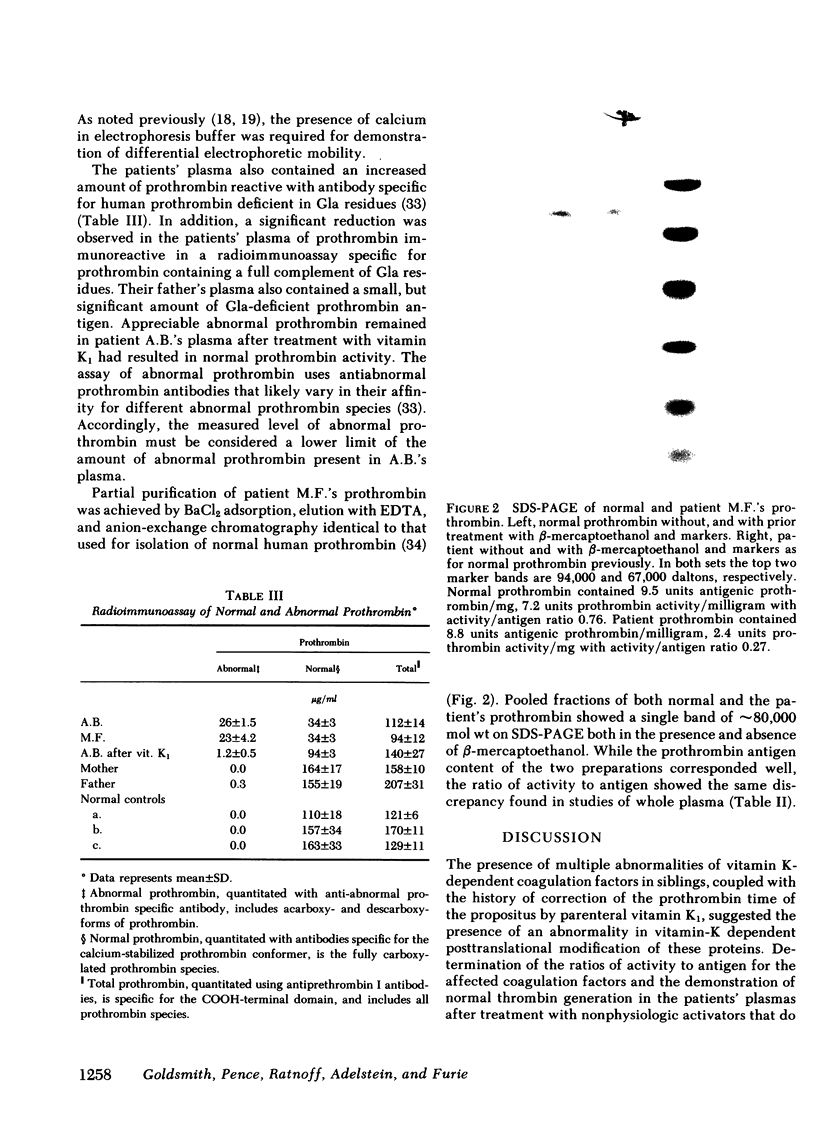

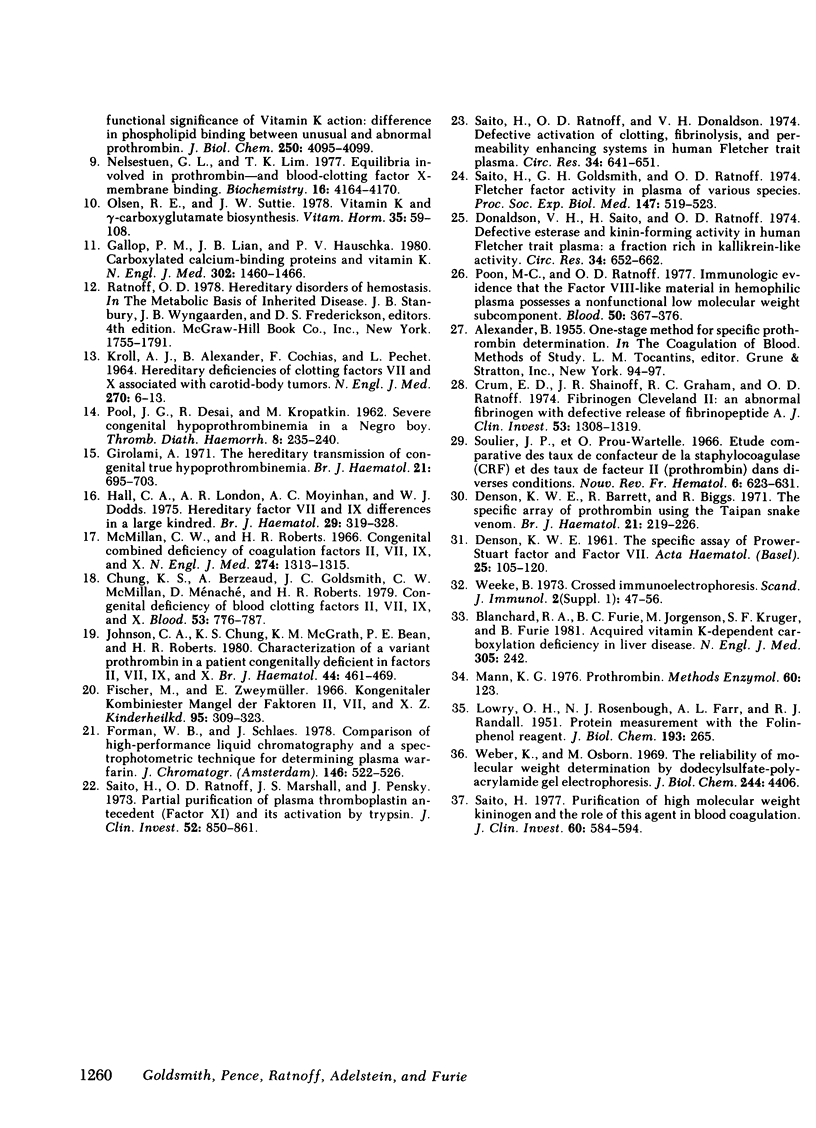
Images in this article
Selected References
These references are in PubMed. This may not be the complete list of references from this article.
- Blanchard R. A., Furie B. C., Jorgensen M., Kruger S. F., Furie B. Acquired vitamin K-dependent carboxylation deficiency in liver disease. N Engl J Med. 1981 Jul 30;305(5):242–248. doi: 10.1056/NEJM198107303050502. [DOI] [PubMed] [Google Scholar]
- Chung K. S., Bezeaud A., Goldsmith J. C., McMillan C. W., Ménaché D., Roberts H. R. Congenital deficiency of blood clotting factors II, VII, IX, and X. Blood. 1979 Apr;53(4):776–787. [PubMed] [Google Scholar]
- Crum E. D., Shainoff J. R., Graham R. C., Ratnoff O. D. Fibrinogen Cleveland II. An abnormal fibrinogen with defective release of fibrinopeptide A. J Clin Invest. 1974 May;53(5):1308–1319. doi: 10.1172/JCI107678. [DOI] [PMC free article] [PubMed] [Google Scholar]
- DENSON K. W. The specific assay of Prower-Stuart factor and factor VII. Acta Haematol. 1961 Feb;25:105–120. doi: 10.1159/000206523. [DOI] [PubMed] [Google Scholar]
- Denson K. W., Borrett R., Biggs R. The specific Assay of prothrombin using the Taipan snake venom. Br J Haematol. 1971 Aug;21(2):219–226. doi: 10.1111/j.1365-2141.1971.tb03432.x. [DOI] [PubMed] [Google Scholar]
- Donaldson V. H., Saito H., Ratnoff O. D. Defective esterase and kinin-forming activity in human Fletcher trait plasma. A fraction rich in kallikreinlike activity. Circ Res. 1974 May;34(5):652–662. doi: 10.1161/01.res.34.5.652. [DOI] [PubMed] [Google Scholar]
- Esmon C. T., Sadowski J. A., Suttie J. W. A new carboxylation reaction. The vitamin K-dependent incorporation of H-14-CO3- into prothrombin. J Biol Chem. 1975 Jun 25;250(12):4744–4748. [PubMed] [Google Scholar]
- Esmon C. T., Suttie J. W., Jackson C. M. The functional significance of vitamin K action. Difference in phospholipid binding between normal and abnormal prothrombin. J Biol Chem. 1975 Jun 10;250(11):4095–4099. [PubMed] [Google Scholar]
- Forman W. B., Shlaes J. Comparison of high-performance liquid chromatography and a spectrophotometric technique for determining plasma warfarin. J Chromatogr. 1978 Nov 1;146(3):522–526. doi: 10.1016/s0378-4347(00)81216-5. [DOI] [PubMed] [Google Scholar]
- Furie B. C., Blumenstein M., Furie B. Metal binding sites of a gamma-carboxyglutamic acid-rich fragment of bovine prothrombin. J Biol Chem. 1979 Dec 25;254(24):12521–12530. [PubMed] [Google Scholar]
- Gallop P. M., Lian J. B., Hauschka P. V. Carboxylated calcium-binding proteins and vitamin K. N Engl J Med. 1980 Jun 26;302(26):1460–1466. doi: 10.1056/NEJM198006263022608. [DOI] [PubMed] [Google Scholar]
- Girolami A. The hereditary transmission of congenital 'true' hypoprothrombinaemia. Br J Haematol. 1971 Dec;21(6):695–703. [PubMed] [Google Scholar]
- Hall C. A., London A. R., Moynihan A. C., Dodds W. J. Hereditary factor VII and IX deficiencies in a large kindred. Br J Haematol. 1975 Feb;29(2):319–328. doi: 10.1111/j.1365-2141.1975.tb01826.x. [DOI] [PubMed] [Google Scholar]
- Johnson C. A., Chung K. S., McGrath K. M., Bean P. E., Roberts H. R. Characterization of a variant prothrombin in a patient congenitally deficient in factors II, VII, IX and X. Br J Haematol. 1980 Mar;44(3):461–469. doi: 10.1111/j.1365-2141.1980.tb05916.x. [DOI] [PubMed] [Google Scholar]
- KROLL A. J., ALEXANDER B., COCHIOS F., PECHET L. HEREDITARY DEFICIENCIES OF CLOTTING FACTORS VII AND X ASSOCIATED WITH CAROTID-BODY TUMORS. N Engl J Med. 1964 Jan 2;270:6–13. doi: 10.1056/NEJM196401022700102. [DOI] [PubMed] [Google Scholar]
- LOWRY O. H., ROSEBROUGH N. J., FARR A. L., RANDALL R. J. Protein measurement with the Folin phenol reagent. J Biol Chem. 1951 Nov;193(1):265–275. [PubMed] [Google Scholar]
- Magnusson S., Sottrup-Jensen L., Petersen T. E., Morris H. R., Dell A. Primary structure of the vitamin K-dependent part of prothrombin. FEBS Lett. 1974 Aug 25;44(2):189–193. doi: 10.1016/0014-5793(74)80723-4. [DOI] [PubMed] [Google Scholar]
- Mann K. G. Prothrombin. Methods Enzymol. 1976;45:123–156. doi: 10.1016/s0076-6879(76)45016-4. [DOI] [PubMed] [Google Scholar]
- McMillan C. W., Roberts H. R. Congenital combined deficiency of coagulation factors II, VII, IX and X. Report of a case. N Engl J Med. 1966 Jun 9;274(23):1313–1315. doi: 10.1056/NEJM196606092742309. [DOI] [PubMed] [Google Scholar]
- Nelsestuen G. L., Lim T. K. Equilibria involved in prothrombin- and blood-clotting factor X-membrane binding. Biochemistry. 1977 Sep 20;16(19):4164–4171. doi: 10.1021/bi00638a005. [DOI] [PubMed] [Google Scholar]
- Nelsestuen G. L., Zytkovicz T. H., Howard J. B. The mode of action of vitamin K. Identification of gamma-carboxyglutamic acid as a component of prothrombin. J Biol Chem. 1974 Oct 10;249(19):6347–6350. [PubMed] [Google Scholar]
- Olson R. E., Suttie J. W. Vitamin K and gamma-carboxyglutamate biosynthesis. Vitam Horm. 1977;35:59–108. doi: 10.1016/s0083-6729(08)60521-x. [DOI] [PubMed] [Google Scholar]
- POOL J. G., DESAI R., KROPATKIN M. Severe congenital hypoprothrombinemia in a Negro boy. Thromb Diath Haemorrh. 1962 Nov 15;8:235–240. [PubMed] [Google Scholar]
- Poon M. C., Ratnoff O. D. Immunologic evidence that the antihemophilic factor (factor VIII)-like material in hemophilic plasma possesses a nonfunctional low molecular weight subcomponent. Blood. 1977 Sep;50(3):367–376. [PubMed] [Google Scholar]
- Saito H., Goldsmith G., Ratnoff O. D. Fletcher factor activity in plasmas of various species. Proc Soc Exp Biol Med. 1974 Nov;147(2):519–523. doi: 10.3181/00379727-147-38378. [DOI] [PubMed] [Google Scholar]
- Saito H. Purification of high molecular weight kininogen and the role of this agent in blood coagulation. J Clin Invest. 1977 Sep;60(3):584–594. doi: 10.1172/JCI108810. [DOI] [PMC free article] [PubMed] [Google Scholar]
- Saito H., Ratnoff O. D., Donaldson V. H. Defective activation of clotting, fibrinolytic, and permeability-enhancing systems in human Fletcher trait plasma. Circ Res. 1974 May;34(5):641–651. doi: 10.1161/01.res.34.5.641. [DOI] [PubMed] [Google Scholar]
- Saito H., Ratnoff O. D., Marshall J. S., Pensky J. Partial purification of plasma thromboplastin antecedent (factor XI) and its activation by trypsin. J Clin Invest. 1973 Apr;52(4):850–861. doi: 10.1172/JCI107249. [DOI] [PMC free article] [PubMed] [Google Scholar]
- Shah D. V., Suttie J. W. The vitamin K dependent, in vitro production of prothrombin. Biochem Biophys Res Commun. 1974 Oct 23;60(4):1397–1402. doi: 10.1016/0006-291x(74)90353-2. [DOI] [PubMed] [Google Scholar]
- Soulier J. P., Prou-Wartelle O. Etude comparative des taux de cofacteur de la staphylocoagulase (C.R.F.) et des taux de facteur II (prothrombine) dans diverses conditions. Nouv Rev Fr Hematol. 1966 Sep-Oct;6(5):623–636. [PubMed] [Google Scholar]
- Sperling R., Furie B. C., Blumenstein M., Keyt B., Furie B. Metal binding properties of gamma-carboxyglutamic acid. Implications for the vitamin K-dependent blood coagulation proteins. J Biol Chem. 1978 Jun 10;253(11):3898–3906. [PubMed] [Google Scholar]
- Stenflo J., Fernlund P., Egan W., Roepstorff P. Vitamin K dependent modifications of glutamic acid residues in prothrombin. Proc Natl Acad Sci U S A. 1974 Jul;71(7):2730–2733. doi: 10.1073/pnas.71.7.2730. [DOI] [PMC free article] [PubMed] [Google Scholar]
- Weber K., Osborn M. The reliability of molecular weight determinations by dodecyl sulfate-polyacrylamide gel electrophoresis. J Biol Chem. 1969 Aug 25;244(16):4406–4412. [PubMed] [Google Scholar]
- Weeke B. Crossed immunoelectrophoresis. Scand J Immunol Suppl. 1973;1:47–56. doi: 10.1111/j.1365-3083.1973.tb03778.x. [DOI] [PubMed] [Google Scholar]



